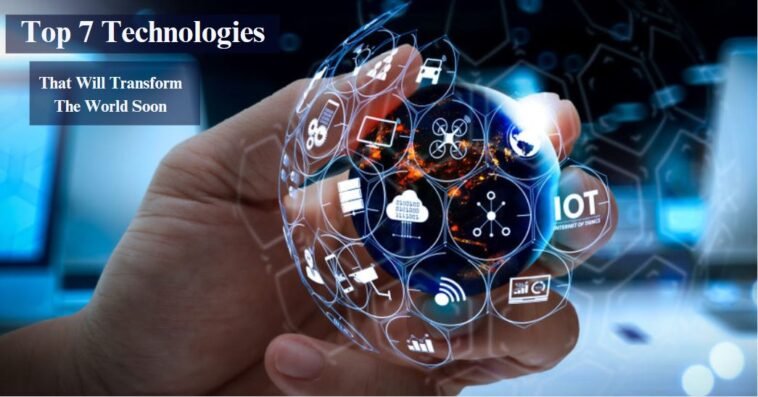Technology advancement plays a vital role for the growth of any industry. Technology is evolving quickly and innovations have made ideas that were previously the things of science fiction a reality for everyone. Technology has had the capability to transform all things, from the growth of artificial intelligence (AI) to the internet of things (IoT) and quantum computing. Let’s look into the top 7 technology trends that have led to these developments and will do so for some time in the future.
Good Read: WebDriver and Test Automation Frameworks: A Comparison and Evaluation
Artificial Intelligence

Artificial intelligence, or AI, has been the topic of much discussion over the past decades, even though it is still one of the newest technological trends. The impact of AI-ML on daily life is already greater than you could imagine. AI technology revolutionizes practically all facets of modern life. The supremacy of AI in fields like speech and image recognition, navigation apps, smartphones personal assistants, ride-sharing apps, and many other fields is already widely recognised. With the aid of AI, smart devices can monitor, gather, and interpret pertinent data, apply learnt intelligence to make the best choices and discoveries, and do so at breakneck speeds that far outpace those of most human capabilities. By 2025, the AI market will be worth $190 billion, with over $57 billion expected to be spent globally on cognitive and AI systems in 2023.
Gene Technology

Genomics is Biology’s interdisciplinary field which concentrates on comprehending and manipulating the DNA and genomes of living things. A group of technologies known as “gene editing” allow for genetic engineering to change the DNA and genetic makeup of living things. The ability to change the DNA coded within a cell is now possible thanks to biotechnology, which will have an impact on the characteristics that the cell’s descendants will inherit. This could have an impact on the leaf count or color, whereas it might have an impact on a human height, eye color, or risk of contracting a disease. This creates an almost infinite number of options because it implies that any inherited trait in a living thing might possibly be altered. It is simple to get carried away when considering possibilities like eradicating disease or even infinitely extending human life when dealing with something that has the potential to change society as much as genomics. If any significant advancements are indeed possible, they are most likely a long way off in reality. In the short run, it is going to be more fruitful to concentrate on solving smaller issues that will have a quick real-world impact.
Human-Computer Interfaces

Human-computer interface (HCI) refers to the means of interaction between a computer system and a human user, particularly when input/output devices are used in conjunction with supporting software. Human-computer interfaces provide wearable devices and technologies that enhance human performance physically and maybe mentally and enable us to live happier and more fulfilled lives. Fitness tracker bands and best smartwatches are two of the most common types of wearables available today. These compact, comfortable gadgets are used to monitor our activity and offer insights that help us live more healthy, better, and more productive lives.
The variety of wearables will increase as technology becomes more compact and intelligent, and new, smaller, and more intelligent goods will replace the wearables we are accustomed to today. Technology holds out the possibility of extending our lives and making them more healthy, possibly even giving us the ability to live indefinitely, but most likely only for people who have the means to afford it.
Extended Reality (XR)

Mixed reality (MR), virtual reality (VR), and augmented reality (AR) are subsets of extended reality (ER). When developers and tech firms around the world started using technologies such as augmented and virtual reality, the idea of extended reality (XR) emerged. These technologies include, for instance, artificial intelligence (AI), the internet of things (IoT), the 5G network, and others as well. The complete range of real and virtual worlds is covered by XR.
It is expected that XR technology would improve and change a number of industries in 2023, like entertainment, education, healthcare, retail, and more. Through the development of higher-resolution displays, wider fields of view, and advanced sensors and cameras, realism will be enhanced. Users will be able to engage with digital content in previously unfeasible ways as a result, improving our capacity for work, learning, and play. In actuality, XR is being utilized to improve workplace learning, increase customer service, let customers experience products before they buy, and other organizational procedures.
3D Printing

3D printing, that is used to create prototypes, is a major innovation and technological trend. The manufacturing and other industries could be substantially transformed by 3D printing, despite the fact that it may appear to be significantly lower tech than gene editing or artificial intelligence. Numerous advantages come with 3D printing technology, but there are also drawbacks, difficulties, and problems that must be faced. We must take into account the environmental impact of the printers themselves, even though it has the potential to lessen the environmental impact of manufacturing by utilizing fewer materials.
Many jobs pay well and are available internationally for businesses in the data and healthcare sectors that depend heavily on 3D printing for their goods. Future manufacturers could easily produce spare parts for equipment on-site using 3D printing. 3D printers have the potential to replace whole assembly lines. One could print food, weapons, and even human tissue for transplants.
Quantum Computing

A type of computing known as quantum computing makes use of quantum phenomena such as superposition and quantum entanglement. Because it is so simple to query, monitor, analyze, and act on data from any source, this wonderful technology trend is also helping to stop the spread of the coronavirus and develop viable vaccines. Banking and finance is another industry where quantum computing is being used for high-frequency trading, fraud detection, and credit risk management.
By 2029, the market for quantum computing is expected to generate more than $2.5 billion in revenue. It might be simpler to manage a lot of data and execute quick simulations with the help of this technology. It could speed up the development of pricey and complex systems, simplify the solution of multi-factor optimisation problems, and address issues that are currently intractable, such as those relating to natural language processing.
Robotic Process Automation (RPA)

Robotic process automation (RPA) is a technology that replicates how people interact with software to carry out repetitive, high-volume tasks. RPA refers to the use of software to automate business operations, including application interpretation, processing transactions, dealing with data, and replying to emails. RPA is becoming more and more popular as a result of its ability to lower costs, streamline processing, and improve customer experiences. RPA builds and deploys a software robot that can run and launch other software. RPA is used in many different sectors and applications today. However, as RPA has gained popularity, businesses are realizing how important it is to incorporate RPA process automations into their IT systems. Despite the fact that RPA automations can significantly speed up a business process that was previously handled by humans, bots are susceptible to break when application interfaces or process workflows change.
Description–


GIPHY App Key not set. Please check settings